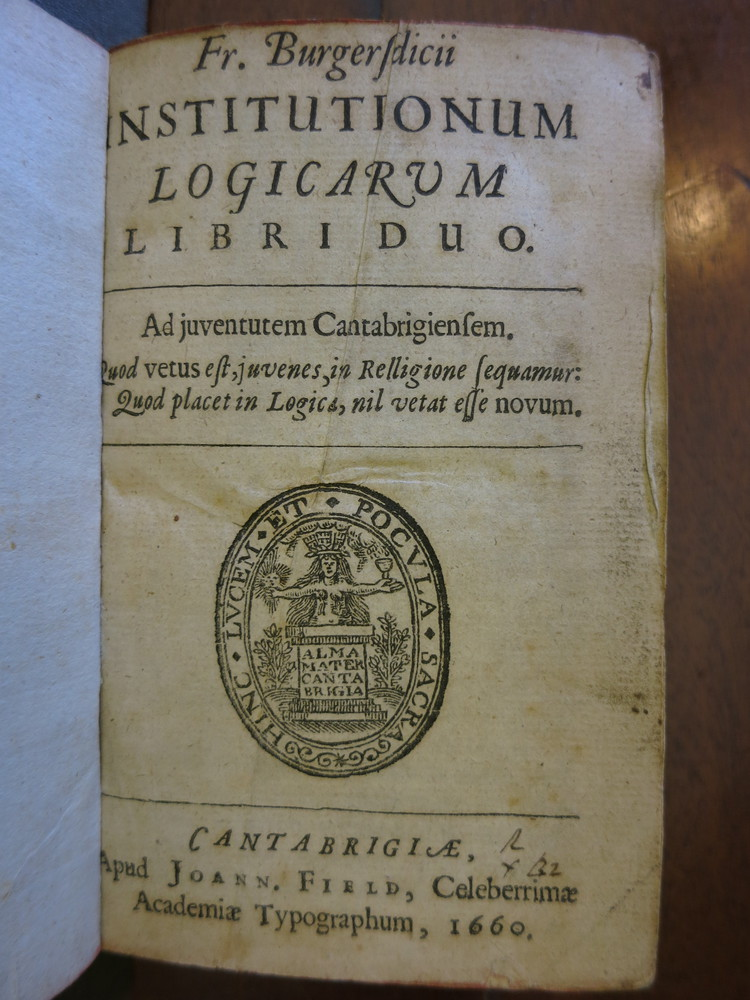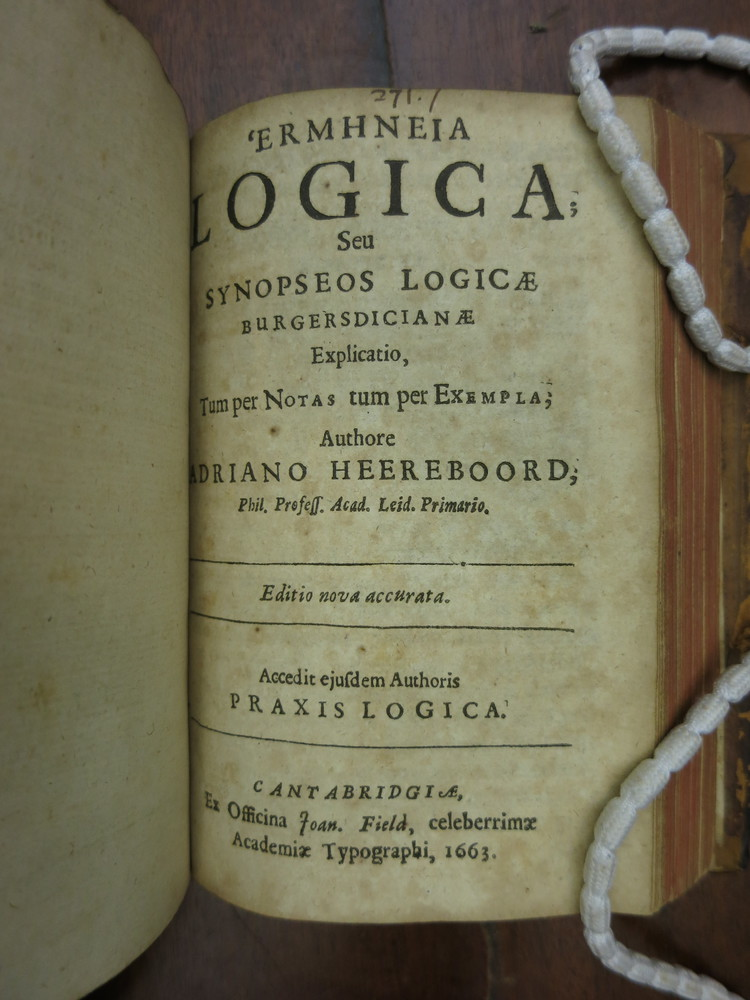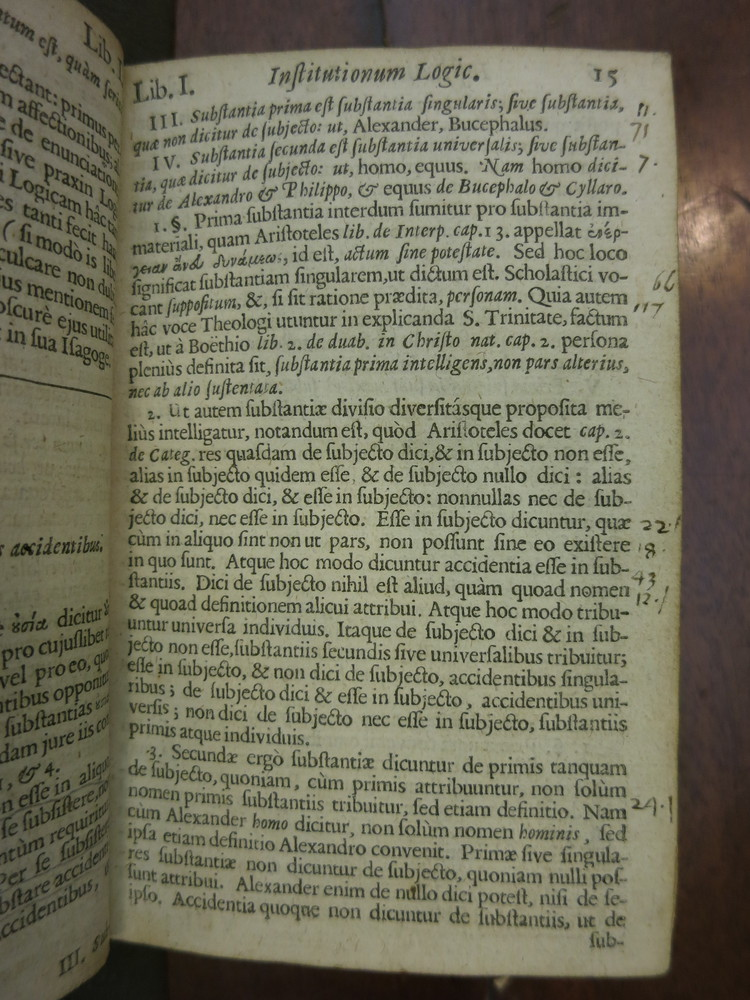My third and final 2020 publication was co-authored with my co-PI, Emma Wilson, and appeared in a special issue of Nineteenth-Century Prose dedicated to Mill. It focused on the volume catalogued as Francis Burgersdicius’s Institutionum Logicarum, which is actually two books printed together, Dutch schoolman Franco Burgersdijk’s textbook Institutionum Logicarum, published in 1660, and his successor Adriaan Heereboord’s Hermēneia Logica, published in 1663:


Each contains an independently paginated preface and main text, with Institutionum Logicarum featuring 24 pages of prefatory material and 357 pages of main text, while Hermēneia Logica offers 6 pages of prefatory material and 311 pages of main text. With roughly three-quarters of the collection now surveyed for handwritten additions, one half of which have been photographed, and one quarter transcribed and uploaded, I can say with some confidence that the book contains the second largest number of individual examples of marginalia of any single volume. In all, 351 of its pages contain at least one mark or annotation, with 1568 total instances.
Over one-third of this total is represented by 576 examples of neatly handwritten numerals. Some of these examples contain multiple numbers separated by periods, however; when these numerical chains are broken into their constituent links, the total quantity of marginal numbers increases to 611. These can be found in three of the four independently numbered sections of Institutiorum Logicarum: 21 in the first set of prefatory pages; 251 in Burgersdijk’s main text; and 339 in the main text of Heereboord. The numbers appear in two forms, with and without a decimal tenth added (i.e., 19 and 19.1). Since when multiple individual numbers appear together in the same annotation they are also separated by periods, this convention only added to the marginalia’s initial inscrutability.
Ultimately, Emma and I were able to discern that the more than 600 handwritten numbers in Burgersdijk’s Institutiorum Logicarum provide an elaborate system of marginal cross-references. Just under 95% (580 of 611) of all numerical annotations in the book lead one to corresponding annotations on the pages referenced by the original numbers. Numbers with a decimal tenth added to them lead one to pages in the other, independently paginated portion of the main text.

Thus, page 15 of part one, pictured above and authored by Burgersdijk, includes, from top to bottom, the handwritten numbers 11, 71, 7, 66, 117, 22.1, 18, 43, 12.1, and 24.1. Similarly, pages 11, 7, 66, 117, 18, and 43 of part one contain a handwritten “15” in the margin, whereas pages 22, 12, and 24 of part two, authored by Heereboord, all feature “15.1”; moreover, each of the pages referred to by page 15 also contains additional numbers that, on the basis of other subjects, lead one to further pages.
Of the remaining 31 numbers for which there are no apparent corresponding pairs, 21 appear in the prefatory pages of Burgersdijk’s half of the volume. Here, they provide page numbers, odd numbers only, in the top corner of pages that are otherwise only identified by their section headings (i.e., “Dedicatio” or “Præfatio ad Lectorem”), allowing for marginal cross references between these now-numbered early pages. Alas, the final ten numbers resisted all of our efforts to decode them.
Nevertheless, sorting out the function of 601 of the 611 marginal numbers allowed us to compare the printed text adjacent to Mill’s handwritten numbers, concentrating for the purposes of our article on those appearing in Burgersdijk’s half of the volume. In so doing, we discovered that, even in his tweens, Mill was already embarking on the intellectual trajectory that would ultimately result in his own System of Logic (1843). His marginal numbers allowed him to move quickly between, to cite only a few examples, 1) similar passages exhorting a sound logical education as the basis for the correct and upright running of a nation, 2) Burgersdijk’s hierarchical classification of logicians into a “first,” “second,” and “third” class, as well as other ways of structuring learning about logic, 3) the Dutchman’s definition of logic, 4) his enumeration of the four instruments of logic (definition, division, syllogism, and method), 5) his connection between the practice of logic and the development of lasting intellectual habits, and 6) his taxonomy of causes, including his differentiations between “proegumenic” and “procatarctic” causality.
Constructing this dense network of marginal numbers was, undoubtedly, an enormous amount of work. It is also work that would need to be done while the book was fresh in one’s mind, perhaps with the aid of now-lost handwritten notes, as the range of cross-references spans the entire volume, in 80 instances pointing out corresponding passages in the separate treatises written by Burgersdijk and Heereboord, respectively. Whenever the numbers were added—and this is a chronological detail that we are likely never to be able to pinpoint—they were a significant addition to a text already crowded with evidence for Mill’s close engagement and sustained dialogue.
—Albert Pionke, Project Director